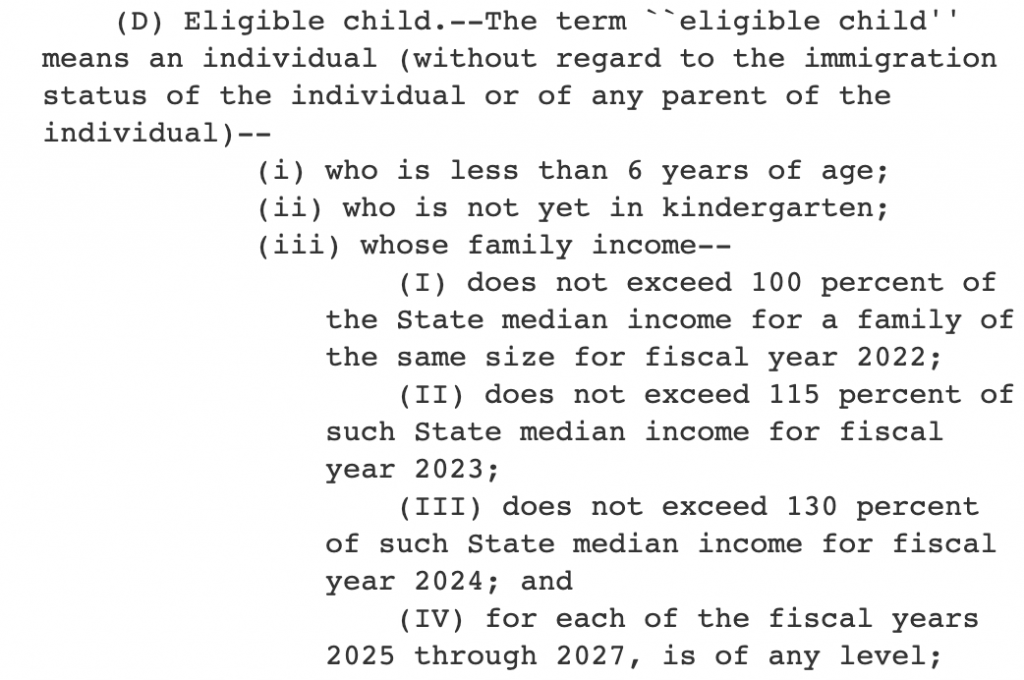Yesterday’s piece used some back-of-the-envelope math to show that the Democratic child care proposal would majorly increase the unsubsidized price of child care and therefore the cost of child care for middle class families with incomes too high to be eligible for subsidies in the first three years of the program.
This piece generated a lot of discussion, including some people claiming that the analysis is wrong. I will address the points I saw, some expressed publicly others privately, below.
Middle Class Parents Really Are Excluded from Subsidies In The First 3 Years
The first response I got from someone in Congress was that the legislation provides sliding-scale subsidies that cap family copayments at 7 percent in the first year of the program.
They were looking at this language in the bill:
A full copayment described in clause (i) shall use a sliding fee scale that provides that, for a family with a family income– (V) of more than 150 percent of the State median income for a family of the same size, the copayment shall be 7 percent of that family income, toward such cost for all such children.
This rule is present in the program from year one. But in order to be eligible for any subsidy from the program, you must also be an “eligible child” defined as follows:

According to this definition, in years 1, 2, and 3 of the program, children are only eligible if their parents have incomes that are at or below 100 percent, 115 percent, and 130 percent of the state median income respectively. A family income that is just one dollar above those thresholds disqualifies you entirely from subsidies during the first 3 years. As I noted in yesterday’s piece, the median national household income is around $67,000.
Perhaps many members of Congress and their staff were unaware of these benefit cliffs in the first few years of the program. Processing all the little details of massive bills like this is not easy to do. But if they do not intend to exclude middle class families from subsidies in the first three years of the program, then they need to amend the bill.
The Unsubsidized Price of Child Care Really Will Increase
The second response was that the unsubsidized price of child care wont actually go up in the first three years of the program. Well, nobody actually said exactly that, but there were a handful of adjacent points that seem to gesture in that direction without actually saying it.
Under the legislation, state plans implementing the child care scheme are required to pay wages “equivalent to wages for elementary educators with similar credentials and experience in the State.” Based on this text and what advocates have said about the program, I simply ticked up child care worker salaries from their current levels to the levels of kindergarten teachers to come up with the price rise number in my piece.
A policy analyst at another think tank said that the “similar credentials and experience” proviso will be used by states to pay child care workers less than what kindergarten teachers make. This is possible though, under the legislation, child care providers are required to credential up to some degree. This analyst said that they think child care salaries will go up to $45,000, not $60,000. In this scenario, the unsubsidized price of child care goes up by $7,200 per year not $13,000 per year. In either case, this is still a massive cost spike for middle class families who are not eligible for subsidies.
Another point, which was actually put out by the Senate HELP committee, is that the legislation’s wage mandates only have to be met “within 3 years,” with the implicit suggestion of this being that states will be able to avoid wage hikes and unsubsidized price increases in the first 3 years of the program. But there is no way that this is true.
Wages increase under the legislation in part because the legislation requires them to increase, but also because the legislation massively increases demand in a low-wage sector while requiring some credentialing up in the sector. The much higher pay will be needed to actually hire the number of people required to deliver the services being paid for in the bill.
What’s weird about the pushback on this point is that child care advocates seem to understand it perfectly well in other contexts. For example, Elliot Haspel recently wrote in The New Republic that making pre-k free for ages 3 and 4 without also providing child care subsidies for ages 0 through 2 would create huge problems for the child care sector.
What’s more, given existing and horrendous staffing shortages, passing only pre-K would sabotage infant and toddler care in America. Think of it this way: What toddler teacher is going to stick around when she could work with 4-year-olds and make double the money?
Haspel seems more comfortable talking about quantities than prices in his analysis, but the upshot is the same: massively increasing demand in the child care and pre-k sector while only subsidizing some of the users will cause shortages or price hikes for the unsubsidized users. This is true to some extent if you only fund pre-k without funding child care, but even more true if you fund all of pre-k and then child care for families with below-median income without funding child care for families with above-median income.
Under the current scheme, families with children between the ages of 0 and 2 who have income slightly above their state’s median income are being set up to drown under massive child care fee hikes. It is hard to see how anyone could say otherwise, but as I mentioned at the top of this section, nobody is actually saying otherwise.
The Solution
As I noted in my last piece, there are obvious solutions to this problem: make the subsidies available to all families in year one of the program. Alternatively, just make ages 0, 1, and 2 free in the same way that the pre-k section makes ages 3 and 4 free. This will at least insure that there isn’t any group of families sitting on an unsubsidized island as federally-subsidized demand alongside wage mandates and credential mandates spikes all around them.
But of course, even these solutions don’t necessarily mean that these programs will be able to stand up enough child care or pre-k capacity in the first few years of the program to meet the increased number of potential users. This particular problem seems to especially vex policymakers, which also seems to be part of the reason why they have decided to use these goofy benefit cliffs: some view them as a way of managing demand, which is just a more obscurantist way of saying that they are hoping to make child care so unaffordable for families with incomes over the thresholds that they won’t be able to use it, which will free up capacity for the subsidized users.
There is actually a decent solution to this problem as well though. Insofar as we cannot actually provide child care and pre-k spots for everyone on year one of the program due to supply constraints, we can provide families who do not manage to get a spot a home child care allowance instead. As child care capacity increases, the home child care allowance program would naturally wind down as parents choose to take advantage of the newly open spots. Once supply was adequate, you could end the home child care allowance program, or, if you want to be like Norway and Finland, you could just keep it around as a permanent option for parents who would prefer to take care of their young kids themselves rather than use subsidized child care services.

